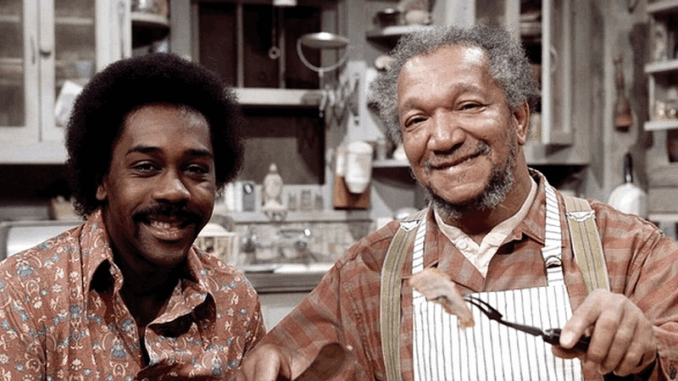
The Secret History of a Banned Scene
Sanford and Son is a cornerstone of American television history. For five seasons, the sitcom delivered laughs, cultural commentary, and iconic catchphrases, all centered around the lovable but curmudgeonly junkman Fred G. Sanford and his long-suffering son, Lamont. The show was a groundbreaking success, not just for its ratings but for its role in bringing a predominantly Black cast into millions of living rooms across the nation. Yet, despite its groundbreaking nature, the show was not immune to the strict moral and comedic standards of its time. In fact, a famous and long-rumored incident reveals a clash between the raw, unfiltered comedic genius of its star and the rigid rules of network television: a scene so controversial, NBC banned it from ever being shown.
The Genius Behind the Junk
To understand why a scene was banned, we first have to appreciate the comedic landscape of Sanford and Son. The show was a vehicle for the legendary Redd Foxx, a veteran of the nightclub circuit known for his raunchy, no-holds-barred stand-up comedy. While the sitcom format required him to clean up his act, his signature style—a rapid-fire delivery of insults, witty one-liners, and a genius for improvisation—was the show’s heart and soul.
The dynamic between Foxx’s Fred and Demond Wilson’s Lamont was built on a foundation of genuine chemistry and a constant battle of wits. The show was famous for its unscripted moments and the constant ad-libbing by Foxx. These off-the-cuff jokes and reactions, while often brilliant, sometimes pushed the boundaries of what was acceptable for a family-friendly, primetime television slot in the 1970s. The network, in a constant state of vigilance, had to police this raw humor to ensure it conformed to their standards and practices.
The Rumored Banned Moment
While many bloopers and unscripted moments were simply edited out of the final cut, one specific scene became legendary among the cast and crew for its level of controversy. The scene, which was reportedly from a rehearsal or outtake and never meant for broadcast, involved a joke that was considered far too vulgar for television.
The story goes that during a medical examination scene, Redd Foxx ad-libbed a line that made a crude reference to a part of the human anatomy. While the exact wording is lost to time and blurred by anecdote, the joke was so far beyond the pale of 1970s network TV that it became a running joke among the cast and crew about what they couldn’t say. This particular moment serves as a perfect illustration of the constant tension between Redd Foxx’s natural comedic style and the network’s strict censorship. The joke wasn’t part of the script, but its existence and the network’s absolute refusal to even consider it for airing highlights the stark divide between the show’s on-screen persona and its off-screen reality.
Why the Network Cried Foul
The decision to ban such a scene (or any similar ad-libbed, crude humor) was rooted in the television landscape of the era. The 1970s were a time of rapid social change, but television still operated under a strict set of rules. Jokes about anatomy, profanity, and explicit sexual references were simply not allowed. For NBC, the stakes were incredibly high. Sanford and Son was a massive ratings hit and a key part of their primetime lineup. They had a responsibility to their advertisers and a conservative viewing audience to maintain a clean, family-friendly image.
The network was also deeply aware of the show’s cultural significance. As one of the few sitcoms at the time to feature a Black cast, Sanford and Son was under immense scrutiny. Any controversy, especially one related to obscenity, could damage the show’s reputation and lead to boycotts from viewers and advertisers. The censors’ job was to protect the show’s brand and the network’s interests, even if it meant sacrificing a few laughs from their comedic genius star.
The Clash of Styles and the Legacy of Unfiltered Comedy
The story of the “banned scene” is emblematic of a larger, ongoing conflict behind the scenes of Sanford and Son. Redd Foxx’s comedic roots were in the blue-collar, adult-oriented nightclub circuit, where he could say anything he wanted. Television, on the other hand, was a corporate machine with rules, scripts, and a “G-rating” mentality. The frequent battles between Foxx and the network’s censors became legendary. Foxx would often challenge the writers and producers, asking “You want me to say that?” and then proceed to ad-lib a much funnier, and often much cruder, line.
The fact that this struggle is part of the show’s folklore is a testament to its raw, authentic nature. The audience could sense the unscripted energy, the feeling that anything could happen. While the network successfully kept the most egregious jokes off the air, they couldn’t stop the rebellious spirit of the show from seeping through. It was this tension that made Sanford and Son so dynamic and so real.
In retrospect, the “banned scene” is more of a symbol than a specific piece of lost footage. It represents the boundaries of an era and the creative compromises that were often made to bring great art to the masses. The story is a fascinating glimpse into a time when television was finding its voice, often with a little too much raw honesty for the network’s comfort. It’s a reminder that even the most beloved shows have a secret, unfiltered history, and that sometimes, the funniest moments are the ones that were never meant for us to see.
